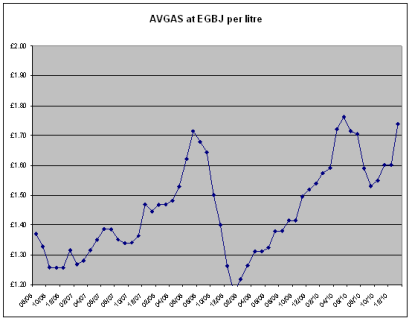In the UK, the price of normal petrol / gasoline has risen swiftly and inexorably like a flood tide from an eye-watering £0.85 pence a litre (yes, litre not gallon!) as recently as January 2009 to an unbelievable £1.30 now (January 2011) and a predicted £1.50 a litre by this summer. All of this is incredibly bad news for anyone that drives a car or rides a motorbike, but these prices seem like a bargain when comparing them to AVGAS fuel prices for light aircraft.

UK Gasoline Prices - per litre
Light aircraft can use a variety of different fuels, depending on the engine(s) being used.
AVGAS
The vast majority of light aircraft are still powered by legacy air-cooled petrol engine made mainly by either Lycoming or Continental (there are a few smaller suppliers). These are amazing beasts in this day and age and the technology used amazes non-aviation aware people, especially those who know a bit about cars. They are literally built using 1930’s technology that has remained completely unchanged to the present day. The engine in my own aircraft is typical. It is a Lycoming 0-320 that delivers a peak of 160 horse power.
The ‘320’ signifies the ‘swept volume’ of the four gigantic cylinders as expressed in cubic inches. Yes, you got that right, four cylinders and a swept volume of 320 cubic inches. For those more familiar with engine capacity expressed in litres, that’s 5.2 litres. Yes, a four cylinder 5.2 LITRE engine that delivers a whopping 160 horse power (not!)! Each cylinder normally has a mere two spark plugs per cylinder with the spark being created by two sets of magnetos – yes, magnetos! One set of mags drive one of the plugs in each cylinder and the second drives the second etc. Actually not such a silly arrangement as it means that if the battery dies, the engine doesn’t care and carries on as happy as Larry. If one set of mags fails, there is a second which continues to run the engine, albeit usually at a slightly lower power level.
What these engine deliver is a very slow revving engine that directly drives the propeller rpm (let’s ignore VP props for now), normally in the cruise of between 2000 – 2400 rpm with a maximum of 2600 rpm. If it turned a normal prop any faster, the tips of the propeller would break the sound barrier and make an incredible noise but more importantly create a lot of supersonic and transonic turbulence which would seriously impact the lift or ‘bite’ of the propeller and therefore it’s ability to pull / push the plane along. An engine revving at these speeds means that you don’t need the added mechanical complexity (the more stuff you have the more points of failure there are) and as important the added weight of an rpm reduction gearbox.
As it is old (for that, read ‘ancient’) technology, these engines must use a high octane leaded gasoline, also called AVGAS. This is 100 octane (also referred to as 100LL for ‘low lead’ to keep the green campaigners happy). This is the sort of fuel that we used to see at the pumps for cars before unleaded fuel became all the rage, albeit for a much higher octane. Now the problem with this is that apart from the miniscule demands of the classic and vintage car market, there is no other commercial demand for high octane leaded fuel than to fuel these antique engines used mainly by private flyers for light aircraft (OK, and of course heavy WW2 warbirds that are still flying). So the market for AVGAS is tiny and producing it is an irritation for oil companies, so by the law of supply and demand, availability of AVGAS in Europe is not good (many French GA airfields run out every summer) and it is very expensive. We have just been hit with a huge hike and pump prices at my airfield are now £1.74 a litre. Given that we get through 25 – 30 litres an hour flying that hurts a lot! The smart money is on AVGAS in the UK being more than £2.00 a litre by the summer.

UK AVGAS Prices - PER LITRE!
By way of comparison with the vibrant US General Aviation industry, they too will tell you that they are staggering around under the burden of an AVGAS price of an eye-watering $5.00 a US Gallon. Now in case you aren’t good at doing conversions that is an exorbitant £0.83 a litre – wait a minute….. £0.83 pence a litre, ARE YOU KIDDING! That’s under half the UK price!!!! Small wonder there is little appetite in the US engine running on MOGAS or AVTUR!
MOGAS
This is just a clever-dicky name for the petrol / gasoline you put into your car. Now I know that it is really hard for a motorist to think that £1.30 for a litre of 95 octane unleaded is a bargain, but imagine if you had a car-type engine in your light aircraft. The fuel burn would be considerably less for about the same horse power (usually 15-20 litres an hour vs 25-30 litres an hour using AVGAS engines) and of course the price per litre would be one-third cheaper litre for litre and a whopping half to two-third cheaper when you also take into account the lower fuel burn for the same power!
The downside? Well, you basically have a modern car engine revving at 4500 rpm for peak efficiency, so you need a reduction gearbox and of course car engines don’t use magnetos, so you are tied to a battery, the battery dies, your engine stops – not nice if you are in the air at the time. Having said that, the engine itself is much smaller and lighter, reduction gearboxes are very reliable as are modern batteries, and you can carry two anyway. The other advantage is that they are water-cooled. So while that adds further addition weight, it means that you really don’t have to worry about engine over-heating at high power setting and low airspeeds (in the climb after take-off) or possible shock-cooling associated with low power settings and normal or high airspeeds (in the descent).
The good news is that there are such engines available in the GA world, they are called ‘Rotax’ engines. The downside is that they are relatively small engines aiming at the very light aircraft end of the market. The largets such engine is the Rotax 914 which can only pump out 115 horse power – so no good for our RV6 which really does need 160 horses. But then they are a measly 1.2 litre engine. Why or why can’t Rotax develop a similar 1.6 or even 2.0 litre engine, God knows there are plenty driving cars around!
Many people (including me) are looking at MOGAS Rotax type engine and the new VLA or ‘Light Sport’ type aircraft now emerging as a longer term and economically viable alternative to AVGAS Lyconosuarus engines.
AVTUR
This is the fuel used worldwide to power the jet and turbine engines you find in commercial aircraft all the way from a modest King Air to the awesome Airbus A380. It is basically a ‘diesel’ type fuel, also very similar / identical to kerosene / paraffin etc. The majority of military jet aircraft also use a kerosene type fuel, either JP5 or JP8. The major difference is that the military fuel types are more fire resistant that regular AVTUR (and unlike what you see in the movies, AVTUR is much less flammable than AVGAS or MOGAS).
GA AVTUR engines are basically nowhere in the USA, and after all, it is the USA who are still the main driver for the General Aviation industry. However, there are a few AVTUR engines around, makers like Thielert, Wilksch etc. Unfortunately, Thielert started with a converted 1.8 litre Mercedes diesel engine which only managed a measly 120hp. They were not a very well managed company and went into administration (from which they are now emerging). But quite a few people were ‘bitten’ by paying for expensive conversions to existing aircraft or buying expensive new Austrian Diamond aircraft (who had a ties up with Thielert) only to find parts impossible and warranties no-existant. But one bad experience should not surely sink what must be the true way forward for light piston engines? Any commercial airfield will have AVTUR and by worldwide convention, AVTUR is sold around the world tax and duty free and runs out at around £0.60 per litre.
Having said that, the UK have cottoned onto that and now have a tax on AVTUR if you use it for non-commercial flying. A tax of £0.54 a litre is mentioned, taking the price up to, but still short of MOGAS prices.
However, the fuel burn is very modest (about the same as a Rotax) and the fuel itself is less flammable. It is very widely available at virtually every airport. This has to be the future, certainly in Europe and it probably won’t be long before the US wake up and have to see that too, how much longer will oil companies continue to produce this hobby fuel of AVGAS?
So bottom line? I can’t wait to see the back of AVGAS and will be looking to switch ideally to an AVTUR single engine piston – now all I need is an established, reliable and proven AVTUR piston engine manufacturer!
